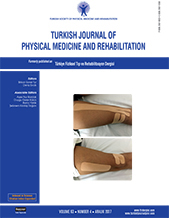The effect of aquatic exercise on spasticity, quality of life and motor function in cerebral palsy
2 Department of Physical Medicine and Rehabilitation, Medical Faculty of Katip Çelebi University, İzmir, Turkey DOI : 10.5606/tftrd.2017.280 Objectives: The primary aim of this study was to compare the effects of aquatic exercises and land-based exercises on spasticity, quality of life, and motor function in children with cerebral palsy (CP). The secondary aim was to assess the morphology of spastic muscle using ultrasonography.
Patients and methods: Thirty-two children (17 boys, 15 girls; mean age 9.7±2.7 years; range 4 to 17 years) with CP were enrolled in this study. The patients were randomly assigned to two groups to receive 30 sessions of an aquatic or a land-based exercise program. The patients were assessed for the impairment level, functional measures, and quality of life before and after therapy. Ultrasonographic assessment of spastic gastrocnemius muscle was also performed.
Results: Both group showed significant improvements in most functional outcome measures. There were no significant differences in the percentage changes of the scores for functional outcome measures between the two groups. However, aquatic exercise produced a higher improvement in quality of life scores than the land-based exercises. Post-treatment ultrasonographic assessment of spastic gastrocnemius muscle showed a significant improvement in the compressibility ratio in the aquatic exercise group. The modified Ashworth Scale score of spastic gastrocnemius muscle in patients with CP showed a negative and weak-to-moderate correlation with the compressibility ratio based on the ultrasonographic evaluation.
Conclusion: Our study results suggest that the aquatic exercises are as effective as land-based exercises for spasticity management and motor function improvement in children with CP. Aquatic exercise can result in a higher level of improvement in quality of life scores than the landbased exercises. Ultrasonographic muscle compressibility ratio may be used to evaluate muscle elasticity in children with CP.
Keywords : Aquatic exercise; cerebral palsy; land-based exercise; spasticity; ultrasonography

















